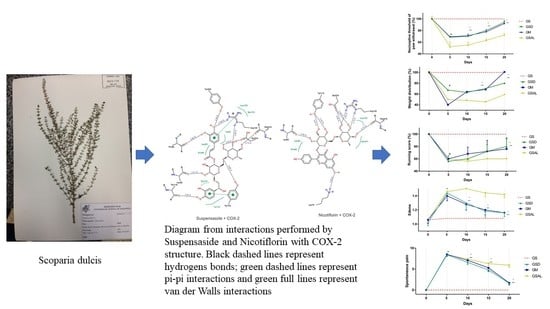Therapeutic Use of Scoparia dulcis Reduces the Progression of Experimental Osteoarthritis
Abstract
:1. Introduction
2. Results
2.1. Evaluation of Mechanical Allodynia—Von Frey
2.2. Assessment of Motor Activity/Forced Walking—Rotarod test
2.3. Functional Incapacity—Weight Bearing Test
2.4. Edematogenic Evaluation
2.5. Rating by Mouse Grimace Scale
2.6. Determination of Inhibition of Cyclooxygenase
2.7. Chemical Analysis
2.8. In Silico Assay
2.9. Determination of Cytokines (in Synovial Fluid)
2.10. Microscopic Classification Articular Cartilage Histology in Osteoarthritis
3. Discussion
4. Materials and Methods
4.1. Animals
4.2. Plant Species
4.3. Obtaining Extract from the Aerial Parts of Scoparia dulcis
4.4. Experimental Protocol
4.5. Sodium MIA-Induced OA Model
4.6. Clinical Evaluations
4.6.1. Motor Activity Assessment—Forced Walking (Rotarod Test)
4.6.2. Weight-Bearing Test/Weight Distribution Test on Hind Legs
4.6.3. Quantification of Mechanical Allodynia (Von Frey Test)
4.7. Mouse Grimace Scale (MGS)
4.8. Edematogenic Evaluation
4.9. Cyclooxygenase (COX) Inhibition
4.10. Chemical Analysis of Crude Extract of S. dulcis
4.11. In silico Assay
4.11.1. Predictive Models and Theoretical Calculations
4.11.2. Molecular Docking
4.12. Laboratory Analysis of Cytokines
4.13. Histopathological Analysis of Articular Cartilage
4.14. Statistical Analysis
5. Conclusions
Author Contributions
Funding
Acknowledgments
Conflicts of Interest
References
- Dieppe, P.A.; Lohmander, L.S. Pathogenesis and management of pain in osteoarthritis. Lancet 2005, 365, 965–973. [Google Scholar] [CrossRef]
- Moon, S.-J.; Woo, Y.-J.; Jeong, J.-H.; Park, M.-K.; Oh, H.-J.; Park, J.-S.; Kim, E.-K.; Cho, M.-L.; Park, S.-H.; Kim, H.-Y. Rebamipide attenuates pain severity and cartilage degeneration in a rat model of osteoarthritis by downregulating oxidative damage and catabolic activity in chondrocytes. Osteoarthr. Cartil. 2012, 20, 1426–1438. [Google Scholar] [CrossRef] [PubMed] [Green Version]
- Yamada, E.F.; Salgueiro, A.F.; Goulart, A.d.S.; Mendes, V.P.; Anjos, B.L.; Folmer, V.; da Silva, M.D. Evaluation of monosodium iodoacetate dosage to induce knee osteoarthritis: Relation with oxidative stress and pain. Int. J. Rheum. Dis. 2019, 22, 399–410. [Google Scholar] [CrossRef] [PubMed]
- Stanos, S. Osteoarthritis guidelines: A progressive role for topical NSAIDs. J. Am. Osteopath. Assoc. 2013, 113, 123–127. [Google Scholar] [PubMed]
- Man, G.; Mologhianu, G. Osteoarthritis pathogenesis–a complex process that involves the entire joint. J. Med. Life 2014, 7, 37. [Google Scholar] [PubMed]
- Rodrigues, T.A.; Freire, A.d.O.; Silva, G.E.B.; Vasconcelos, J.W.; Cartagenes, M.D.S.d.S.; Garcia, J.B.S. Prophylactic and therapeutic use of strontium ranelate reduces the progression of experimental osteoarthritis. Front. Pharmacol. 2018, 9, 975. [Google Scholar] [CrossRef] [PubMed]
- Couto, C.L.L.; Moraes, D.F.C.; Cartágenes, M.d.S.S.; Amaral, F.M.M.; Guerra, R.N. Eleutherine bulbous (Mill.) Urb.: A review study. J. Med. Plants Res. 2016, 10, 286–297. [Google Scholar]
- Coimbra, I.; Pastor, E.; Greve, J.; Puccinelli, M.; Fuller, R.; Cavalcanti, F.; Maciel, F.; Honda, E. Osteoartrite (artrose): Tratamento. Rev. Bras. Reumatol. 2004, 44, 450–453. [Google Scholar] [CrossRef]
- Jeong, J.-H.; Moon, S.-J.; Jhun, J.-Y.; Yang, E.-J.; Cho, M.-L.; Min, J.-K. Eupatilin exerts antinociceptive and chondroprotective properties in a rat model of osteoarthritis by downregulating oxidative damage and catabolic activity in chondrocytes. PLoS ONE 2015, 10. [Google Scholar] [CrossRef] [PubMed]
- Rodrigues, T.; Sampaio Junior, A.; Nunes, I.; Cartágenes, M.; Garcia, J. Effect of strontium ranelate on pain behavior in an experimental model of osteoarthritis. Braz. J. Med. Biol. Res. 2017, 50, 1–5. [Google Scholar] [CrossRef]
- Silva, R.H.; Lima, N.d.F.M.; Lopes, A.J.; Vasconcelos, C.C.; de Mesquita, J.W.; de Mesquita, L.S.; Lima, F.C.; Ribeiro, M.N.d.S.; Ramos, R.M.; Cartágenes, M.S.S.; et al. Antinociceptive activity of borreria verticillata: In vivo and in silico studies. Front. Pharmacol. 2017, 8, 1–14. [Google Scholar] [CrossRef] [PubMed]
- Babincová, M.; Sourivong, P. Free radical scavenging activity of Scoparia dulcis extract. J. Med. Food 2001, 4, 179–181. [Google Scholar] [CrossRef] [PubMed]
- Murti, K.; Panchal, M.; Taya, P.; Singh, R. Pharmacological properties of Scoparia dulcis: A review. Pharmacologia 2012, 3, 344–347. [Google Scholar] [CrossRef]
- Yogeeswari, P.; Sriram, D. Betulinic acid and its derivatives: A review on their biological properties. Curr. Med. Chem. 2005, 12, 657–666. [Google Scholar] [CrossRef]
- Girotti, C.; Ginet, M.; Demarne, F.C.; Lagarde, M.; Géloën, A. Lipolytic activity of cirsimarin extracted from Microtea debilis. Planta Med. 2005, 71, 1170–1172. [Google Scholar] [CrossRef]
- Faujan, N.; Alitheen, N.; Yeap, S.; Ali, A.; Muhajir, A.; Ahmad, F. Cytotoxic effect of betulinic acid and betulinic acid acetate isolated from Melaleuca cajuput on human myeloid leukemia (HL-60) cell line. Afr. J. Biotechnol. 2010, 9, 6387–6396. [Google Scholar]
- Souza, R.K.D.; da Silva, M.A.P.; de Menezes, I.R.A.; Ribeiro, D.A.; Bezerra, L.R.; de Almeida Souza, M.M. Ethnopharmacology of medicinal plants of carrasco, northeastern Brazil. J. Ethnopharmacol. 2014, 157, 99–104. [Google Scholar] [CrossRef] [PubMed]
- Ratnasooriya, W.; Galhena, G.; Liyanage, S.; Jayakody, J. Analgesic and antihyperalgesic effects of Scoparia dulcis decoction in rats. J. Trop. Med. Plants 2002, 4, 63. [Google Scholar]
- Gouveia-Figueira, S.C.; Castilho, P.C. Phenolic screening by HPLC–DAD–ESI/MSn and antioxidant capacity of leaves, flowers and berries of Rubus grandifolius Lowe. Ind. Crop. Prod. 2015, 73, 28–40. [Google Scholar] [CrossRef]
- TOXNET. Available online: https://chem.nlm.nih.gov/chemidplus/ (accessed on 20 August 2019).
- Iwashina, T.; Matsumoto, S. Flavonoid glycosides from the Fern, Schizaea (Schizaeaceae) in south pacific region, and their distribution pattern. Bull. Nat. Museum Nat. Sci. Ser. B. 2013, 39, 195–201. [Google Scholar]
- Guo, H.; Liu, A.H.; Ye, M.; Yang, M.; Guo, D.A. Characterization of phenolic compounds in the fruits of Forsythia suspensa by high-performance liquid chromatography coupled with electrospray ionization tandem mass spectrometry. Rapid. Commun. Mass Spectrom. 2007, 21, 715–729. [Google Scholar] [CrossRef] [PubMed]
- Roriz, C.L.; Barros, L.; Carvalho, A.M.; Santos-Buelga, C.; Ferreira, I.C. Pterospartum tridentatum, Gomphrena globosa and Cymbopogon citratus: A phytochemical study focused on antioxidant compounds. Food Res. Int. 2014, 62, 684–693. [Google Scholar] [CrossRef] [Green Version]
- Negri, G.; Tabach, R. Saponins, tannins and flavonols found in hydroethanolic extract from Periandra dulcis roots. Rev. Bras. Farmacogn. 2013, 23, 851–860. [Google Scholar] [CrossRef] [Green Version]
- Li, L.; Tsao, R.; Liu, Z.; Liu, S.; Yang, R.; Young, J.C.; Zhu, H.; Deng, Z.; Xie, M.; Fu, Z. Isolation and purification of acteoside and isoacteoside from Plantago psyllium L. by high-speed counter-current chromatography. J. Chromatogr. 2005, 1063, 161–169. [Google Scholar] [CrossRef] [PubMed]
- Iwashina, T.; Peng, C.-I.; Kokubugata, G. Flavone O-and C-glycosides from Pothos chinensis (Araceae). Bull. Nat. Museum Nat. Sci. 2010, 36, 27–32. [Google Scholar]
- Friščić, M.; Bucar, F.; Hazler Pilepić, K. LC-PDA-ESI-MSn analysis of phenolic and iridoid compounds from Globularia spp. J. Mass Spectrom. 2016, 51, 1211–1236. [Google Scholar] [CrossRef] [PubMed]
- Wang, S.; Liu, L.; Wang, L.; Hu, Y.; Zhang, W.; Liu, R. Structural characterization and identification of major constituents in Jitai tablets by high-performance liquid chromatography/diode-array detection coupled with electrospray ionization tandem mass spectrometry. Molecules 2012, 17, 10470–10493. [Google Scholar] [CrossRef] [PubMed]
- Xu, L.-L.; Xu, J.-J.; Zhong, K.-R.; Shang, Z.-P.; Wang, F.; Wang, R.-F.; Zhang, L.; Zhang, J.-Y.; Liu, B. Analysis of non-volatile chemical constituents of Menthae Haplocalycis herba by ultra-high performance liquid chromatography-high resolution mass spectrometry. Molecules 2017, 22, 1756. [Google Scholar] [CrossRef] [PubMed]
- Ağalar, H.G.; Çiftçi, G.A.; Göger, F.; Kırımer, N. Activity guided fractionation of Arum italicum Miller Tubers and the LC/MS-MS profiles. Rec. Nat. Prod. 2017, 12, 64–75. [Google Scholar] [CrossRef]
- Roughan, J.V.; Bertrand, H.G.; Isles, H.M. Meloxicam prevents COX-2-mediated post-surgical inflammation but not pain following laparotomy in mice. Eur. J. Pain 2016, 20, 231–240. [Google Scholar] [CrossRef] [PubMed]
- Zulfiker, A.; Rahman, M.M.; Hossain, M.K.; Hamid, K.; Mazumder, M.; Rana, M.S. In vivo analgesic activity of ethanolic extracts of two medicinal plants-Scoparia dulcis L. and Ficus racemosa Linn. Biol. Med. 2010, 2, 42–48. [Google Scholar]
- Pamunuwa, G.; Karunaratne, D.; Waisundara, V.Y. Antidiabetic Properties, bioactive constituents, and other therapeutic effects of scoparia dulcis. Evid. Based Complement. Altern. Med. 2016, 2016. [Google Scholar] [CrossRef]
- Ahmed, M.; Shikha, H.A.; Sadhu, S.K.; Rahman, M.T.; Datta, B.K. Analgesic, diuretic, and anti-inflammatory principle from Scoparia dulcis. Pharma 2001, 56, 657–660. [Google Scholar]
- De Farias Freire, S.M.; Da Silva Emim, J.A.; Lapa, A.J.; Souccar, C.; Torres, L.M.B. Analgesic and antiinflammatory properties of Scoparia dulcis L. extracts and glutinol in rodents. Phytother. Res. 1993, 7, 408–414. [Google Scholar] [CrossRef]
- Tsai, J.-C.; Peng, W.-H.; Chiu, T.-H.; Lai, S.-C.; Lee, C.-Y. Anti-inflammatory effects of Scoparia dulcis L. and betulinic acid. Am. J. Chin. Med. 2011, 39, 943–956. [Google Scholar] [CrossRef] [PubMed]
- Furlan, V.; Konc, J.; Bren, U. Inverse molecular docking as a novel approach to study anticarcinogenic and anti-neuroinflammatory effects of curcumin. Molecules 2018, 23, 3351. [Google Scholar] [CrossRef] [PubMed]
- Konc, J. Identification of neurological disease targets of natural products by computational screening. Neural Regen. Res. 2019, 14, 2075. [Google Scholar] [CrossRef] [PubMed]
- Dong, Z.; Lu, X.; Tong, X.; Dong, Y.; Tang, L.; Liu, M. Forsythiae fructus: A review on its phytochemistry, quality control, pharmacology and pharmacokinetics. Molecules 2017, 22, 1466. [Google Scholar] [CrossRef]
- Zhao, J.; Zhang, S.; You, S.; Liu, T.; Xu, F.; Ji, T.; Gu, Z. Hepatoprotective effects of nicotiflorin from nymphaea candida against concanavalin a-induced and d-galactosamine-induced liver injury in mice. Int. J. Mol. Sci. 2017, 18, 587. [Google Scholar] [CrossRef]
- Rowlinson, S.W.; Kiefer, J.R.; Prusakiewicz, J.J.; Pawlitz, J.L.; Kozak, K.R.; Kalgutkar, A.S.; Stallings, W.C.; Kurumbail, R.G.; Marnett, L.J. A novel mechanism of cyclooxygenase-2 inhibition involving interactions with Ser-530 and Tyr-385. J. Biol. Chem. 2003, 278, 45763–45769. [Google Scholar] [CrossRef]
- Xu, S.; Hermanson, D.J.; Banerjee, S.; Ghebreselasie, K.; Clayton, G.M.; Garavito, R.M.; Marnett, L.J. Oxicams bind in a novel mode to the cyclooxygenase active site via a two-water-mediated H-bonding network. J. Biol. Chem. 2014, 289, 6799–6808. [Google Scholar] [CrossRef] [PubMed]
- Orlando, B.J.; Lucido, M.J.; Malkowski, M.G. The structure of ibuprofen bound to cyclooxygenase-2. J. Struct. Biol. 2015, 189, 62–66. [Google Scholar] [CrossRef] [PubMed]
- Fitzgerald, J.B.; Jin, M.; Grodzinsky, A.J. Shear and compression differentially regulate clusters of functionally related temporal transcription patterns in cartilage tissue. J. Biol. Chem. 2006, 281, 24095–24103. [Google Scholar] [CrossRef] [PubMed]
- Kraychete, D.C.; Calasans, M.T.d.A.; Valente, C.M.L. Citocinas pró-inflamatórias e dor. Rev. Bras. Reumatol. 2006, 46, 199–206. [Google Scholar] [CrossRef]
- Zhang, W.; Wang, S.; Zhang, R.; Zhang, Y.; Li, X.; Lin, Y.; Wei, X. Evidence of Chinese herbal medicine Duhuo Jisheng decoction for knee osteoarthritis: A systematic review of randomised clinical trials. BMJ Open 2016, 6. [Google Scholar] [CrossRef] [PubMed]
- Carvalho, W.A.d.; Carvalho, R.D.S.; Rios-Santos, F. Analgésicos inibidores específicos da ciclooxigenase-2: Avanços terapêuticos. Rev. Bras. Anestesiol. 2004, 54, 448–464. [Google Scholar] [CrossRef] [PubMed]
- Vane, J.; Botting, R. New insights into the mode of action of anti-inflammatory drugs. Inflamm. Res. 1995, 44, 1–10. [Google Scholar] [CrossRef] [PubMed]
- Klaumann, P.R.; Wouk, A.; Sillas, T. Patofisiologia da dor. Arch. Vet. Sci. 2008, 13, 1–12. [Google Scholar] [CrossRef]
- de Rezende, M.U.; de Campos, G.C. A osteoartrite é uma doenca mecânica ou inflamatória? Rev. Bras. Ortop. 2013, 48, 471–474. [Google Scholar] [CrossRef]
- Pelletier, J.P.; Martel-Pelletier, J.; Abramson, S.B. Osteoarthritis, an inflammatory disease: Potential implication for the selection of new therapeutic targets. Arthritis Rheum. 2001, 44, 1237–1247. [Google Scholar] [CrossRef]
- Ahmed, A.S.; Li, J.; Erlandsson-Harris, H.; Stark, A.; Bakalkin, G.; Ahmed, M. Suppression of pain and joint destruction by inhibition of the proteasome system in experimental osteoarthritis. Pain 2012, 153, 18–26. [Google Scholar] [CrossRef] [PubMed]
- de Souza, A.N.A.; de Oliveira Saladino, A.; Biasi, C.; Matera, J.M. Uso dos condroprotetores na afecção articular degenerativa: Revisão. Rev. Acad. Ciênc. Anim. 2010, 8, 281–289. [Google Scholar] [CrossRef]
- Velosa, A.P.P.; Teodoro, W.R.; Yoshinari, N.H. Collagen in osteoarthrotic cartilage. Rev. Bras. Reum. 2003, 43, 160–166. [Google Scholar] [CrossRef]
- Krasnokutsky, S.; Attur, M.; Palmer, G.; Samuels, J.; Abramson, S. Current concepts in the pathogenesis of osteoarthritis. Osteoarthr. Cartil. 2008, 16, S1–S3. [Google Scholar] [CrossRef] [PubMed] [Green Version]
- Nagy, E.; Vajda, E.; Vari, C.; Sipka, S.; Fárr, A.-M.; Horváth, E. Meloxicam ameliorates the cartilage and subchondral bone deterioration in monoiodoacetate-induced rat osteoarthritis. PeerJ 2017, 5. [Google Scholar] [CrossRef] [PubMed]
- Freire, S.M.; Torres, L.; Roque, N.F.; Souccar, C.; Lapa, A.J. Analgesic activity of a triterpene isolated from Scoparia dulcis L.(Vassourinha). Mem. Inst. Oswaldo Cruz 1991, 86, 149–151. [Google Scholar] [CrossRef] [PubMed]
- Fernihough, J.; Gentry, C.; Malcangio, M.; Fox, A.; Rediske, J.; Pellas, T.; Kidd, B.; Bevan, S.; Winter, J. Pain related behaviour in two models of osteoarthritis in the rat knee. Pain 2004, 112, 83–93. [Google Scholar] [CrossRef]
- Calado, G.P.; Lopes, A.J.O.; Junior, L.M.C.; Francisco das Chagas, A.L.; Silva, L.A.; Pereira, W.S.; do Amaral, F.M.; Garcia, J.B.S.; Cartágenes, M.S.S.; Nascimento, F.R. Chenopodium ambrosioides L. Reduces synovial inflammation and pain in experimental Osteoarthritis. PLoS ONE 2015, 10. [Google Scholar] [CrossRef]
- Kalff, K.-M.; El Mouedden, M.; van Egmond, J.; Veening, J.; Joosten, L.; Scheffer, G.J.; Meert, T.; Vissers, K. Pre-treatment with capsaicin in a rat osteoarthritis model reduces the symptoms of pain and bone damage induced by monosodium iodoacetate. Eur. J. Pharmacol. 2010, 641, 108–113. [Google Scholar] [CrossRef]
- Vivancos, G.; Verri, W., Jr.; Cunha, T.; Schivo, I.; Parada, C.; Cunha, F.; Ferreira, S. An electronic pressure-meter nociception paw test for rats. Braz. J. Med. Biol. Res. 2004, 37, 391–399. [Google Scholar] [CrossRef] [Green Version]
- Sotocinal, S.G.; Sorge, R.E.; Zaloum, A.; Tuttle, A.H.; Martin, L.J.; Wieskopf, J.S.; Mapplebeck, J.C.; Wei, P.; Zhan, S.; Zhang, S. The Rat Grimace Scale: A partially automated method for quantifying pain in the laboratory rat via facial expressions. Mol. Pain 2011, 7, 55. [Google Scholar] [PubMed]
- da Silva, M.D.; Cidral-Filho, F.J.; Winkelmann-Duarte, E.C.; Cargnin-Ferreira, E.; Calixto, J.B.; Dutra, R.C.; Santos, A.R.S. Diacerein reduces joint damage, pain behavior and inhibits transient receptor potential vanilloid 1, matrix metalloproteinase and glial cells in rat spinal cord. Int. J. Rheum. Dis. 2017, 20. [Google Scholar] [CrossRef]
- Frisch, M.; Trucks, G.; Schlegel, H.; Scuseria, G.; Robb, M.; Cheeseman, J.E.A. Gaussian 09, Revision, D.01. Gaussian, Inc.: Wallingford, CT, USA, 2009. Available online: https://gaussian.com/g09citation/ (accessed on 20 August 2018).
- Dennington, R.; Keith, T.; Millam, J. GaussView. Version 5. Semichem Inc.: Shawnee Mission, KS, USA, 2009. Available online: https://gaussian.com/ (accessed on 24 August 2018).
- Goodsell, D.S.; Morris, G.M.; Olson, A.J. Automated docking of flexible ligands: Applications of AutoDock. J. Mol. Recognit. 1996, 9, 1–5. [Google Scholar] [CrossRef]
- Morris, G.M.; Goodsell, D.S.; Halliday, R.S.; Huey, R.; Hart, W.E.; Belew, R.K.; Olson, A.J. Automated docking using a Lamarckian genetic algorithm and an empirical binding free energy function. J. Comput. Chem. 1998, 19, 1639–1662. [Google Scholar] [CrossRef] [Green Version]
- Pritzker, K.P.; Gay, S.; Jimenez, S.; Ostergaard, K.; Pelletier, J.-P.; Revell, P.; Salter, D.; Van den Berg, W. Osteoarthritis cartilage histopathology: Grading and staging. Osteoarthr. Cartil. 2006, 14, 13–29. [Google Scholar] [CrossRef] [PubMed]
- Aho, O.-M.; Finnilä, M.; Thevenot, J.; Saarakkala, S.; Lehenkari, P. Subchondral bone histology and grading in osteoarthritis. PLoS ONE 2017, 12. [Google Scholar] [CrossRef] [PubMed]
Sample Availability: Samples of the compounds are not available from the authors. |

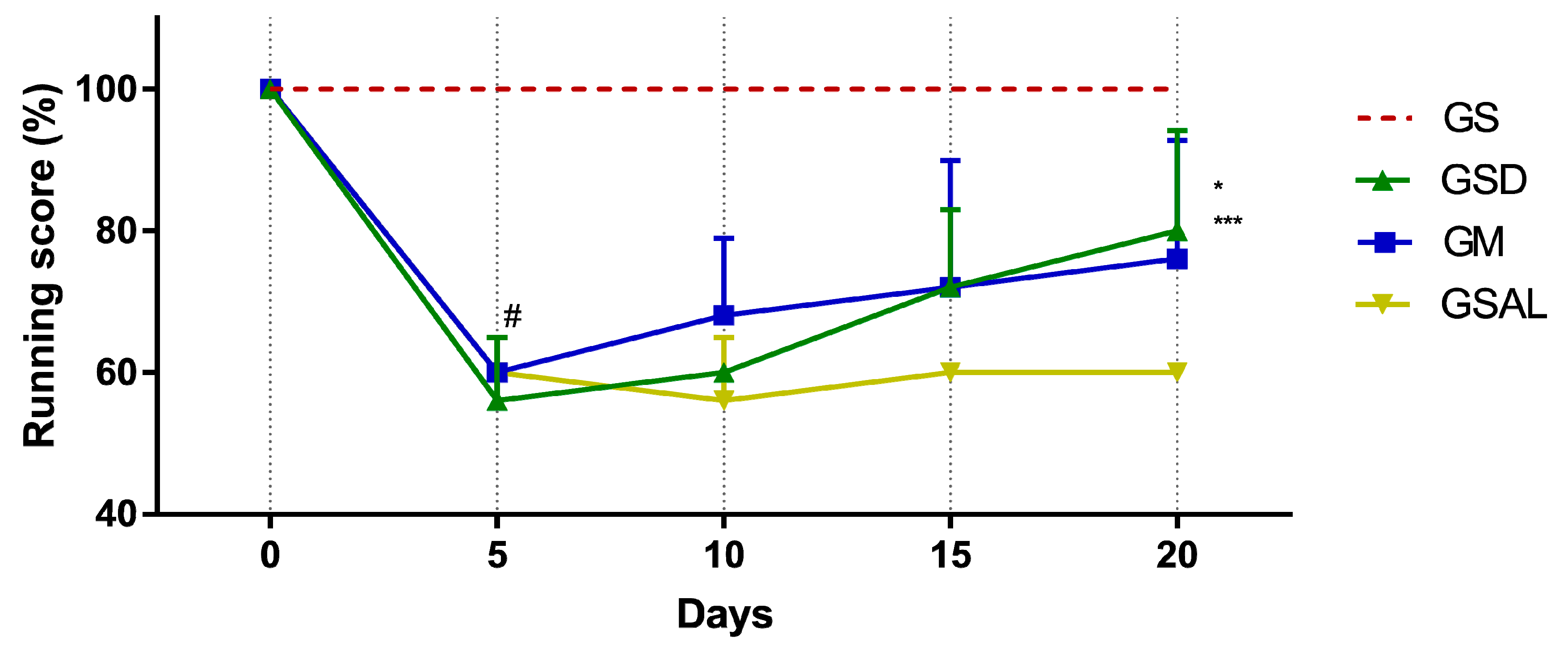
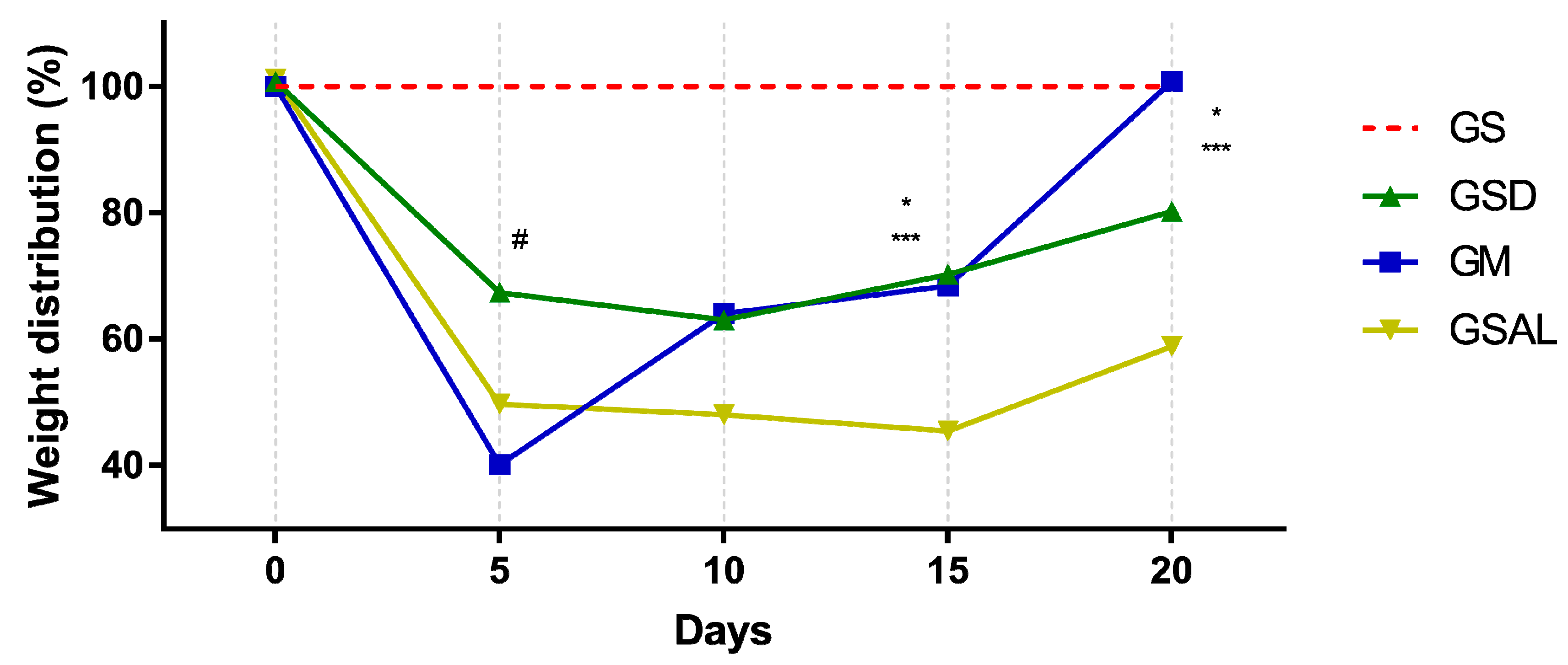

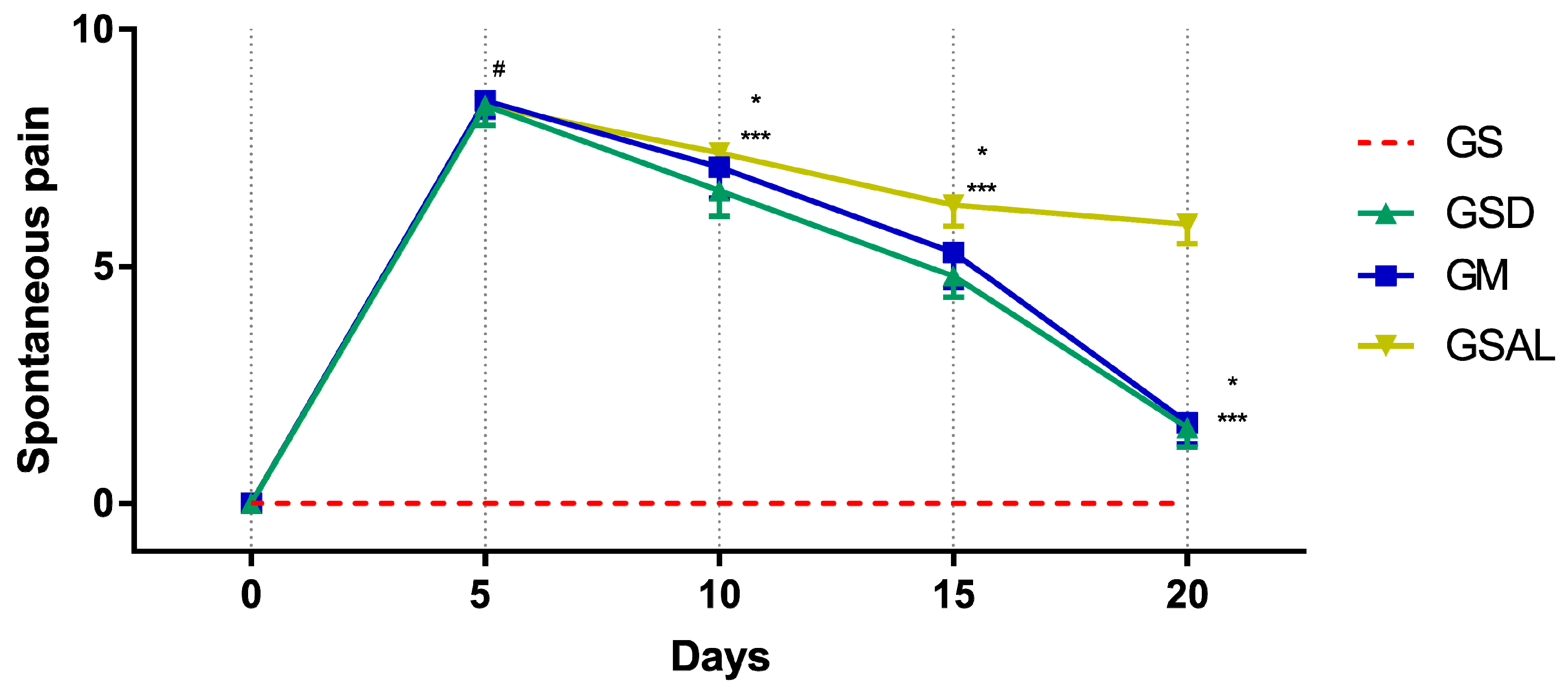

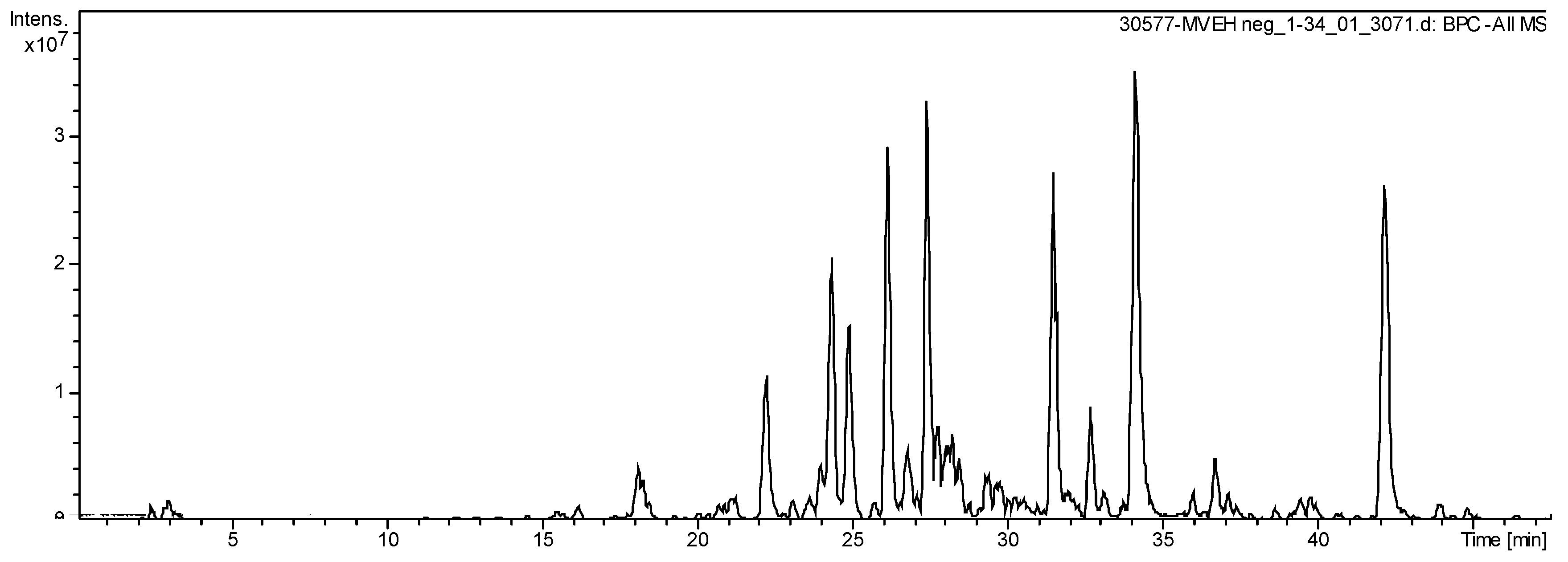


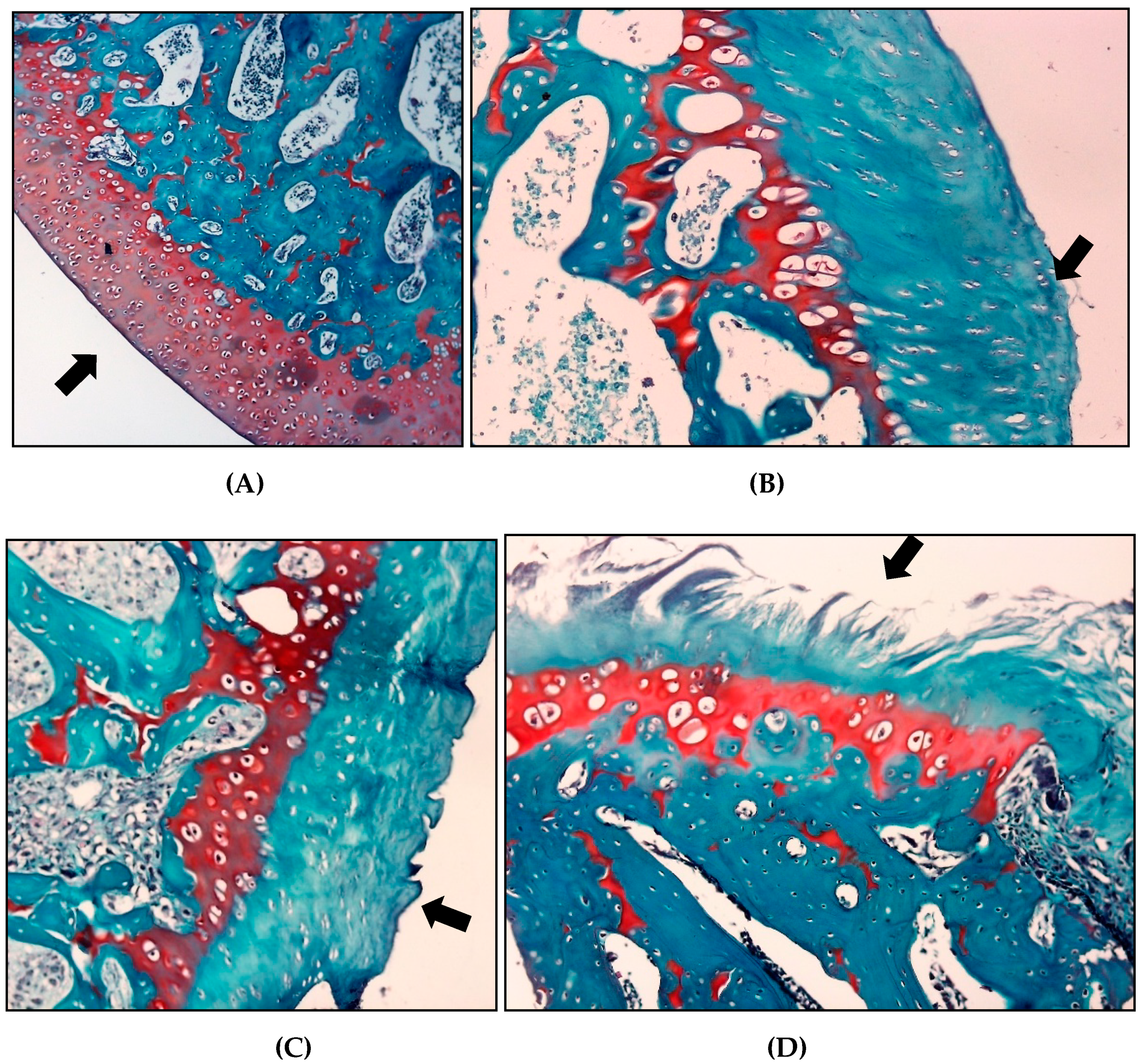
| Peak | Tr (min) | [M − H] − | MSn Fragments | Compound | Reference |
|---|---|---|---|---|---|
| 1 | 18.0 | 417 | 285; 241; 152 | kaempferol-3-O-pentoside | [19] |
| 2 | 20.0 | 327 | 164; 136 | gonzalitosin I | [20] |
| 3 | 22.3 | 593 | 575; 473; 353 | nicotiflorin | [21] |
| 4 | 22.3 | 639 | 621; 529; 459 | suspensaside | [22] |
| 5 | 24.0 | 563 | 545; 473; 353 | apigenin 6-C-pentosyl-8-C-hexoside | [23] |
| 6 | 24.1 | 631 | 563, 479 | myricetin-3-O-(2″-O-galloyl) glucoside | [24] |
| 7 | 24.4 | 1127 | 563 | acteoside dimer | [25] |
| 8 | 26.2 | 623 | 563 | acteoside (verbascoside) | [25] |
| 9 | 26.2 | 623 | 461; 315 | scoparin 7-O-glucoside | [26] |
| 10 | 26.7 | 563 | 473; 443; 353 | apigenin 6-C-pentosyl-8-C-hexoside isomer | [23] |
| 11 | 27.4 | 769 | 623; 607; 461 | deoxyrossicaside A | [27] |
| 12 | 27.4 | 791 | 445; 283 | biochanin A O-hexoside-O-hexoside | [23] |
| 13 | 31.5 | 683 | 637; 313 | Ginsenoside F1 | [28] |
| 14 | 31.5 | 751 | 705; 381 | N.I* | |
| 15 | 32.6 | 797 | 621; 475 | N.I* | |
| 16 | 36.7 | 299 | 284 | 5,7,4′-trihydroxy-3′-methoxyisoflavone (Rhamnocitrin) | [23] |
| 17 | 42.1 | 313 | 297; 283 | Diosmetin | [29] |
| 18 | 44.1 | 327 | 291; 229; 211; 171 | trihydroxyoctadecadienoic acid | [30] |
| Ligand | ΔGbind (kcal.mol−1) * | Ki (μM) ** |
|---|---|---|
| Suspensaside | −9.15 | 0.19 |
| Nicotiflorin | −8.26 | 0.88 |
| Diosmetin | −7.97 | 1.44 |
| Rhamnocitrin | −7.72 | 1.81 |
| Gonzalitosin I | −7.54 | 1.98 |
| Kaempferol-3-O-pentoside | −7.45 | 3.44 |
| Acteoside | −7.33 | 4.22 |
| Meloxicam | −8.89 | 0.30 |
| Cytokines | GSD | GM | GSAL | GS |
|---|---|---|---|---|
| IFN-γ | 1387 ± 71.06 (p = 0.0090) * | 1559 ± 117.9 (p = 0.3103) | 1748 ± 195.7 | 1302 ± 157.8 |
| IL-6 | 35.46 ± 6.78 (p = 0.0300) * | 32.19 ± 11.54 (p = 0.0106) *** | 55.91 ± 8.08 | 24.73 ± 9.92 |
| IL-10 | 384 ± 28.09 | 390.5 ± 22.62 | 276.8 ± 46.76 | 373.2 ± 31.17 |
| (p = 0.0035) * | (p = 0.0019) *** |
| Variables | GSD | GM | GSAL | GS |
|---|---|---|---|---|
| Degree | 2 ± 1.25 | 2.6 ± 0.81 | 3.2 ± 0.95 | 0 ± 0 |
| p-value (GS) p-value (GSAL) | (p = 0.0006) * (p = 0.0492)+ | (p < 0.0001) *** (p = 0.5742) |
© 2019 by the authors. Licensee MDPI, Basel, Switzerland. This article is an open access article distributed under the terms and conditions of the Creative Commons Attribution (CC BY) license (http://creativecommons.org/licenses/by/4.0/).
Share and Cite
Lima, M.V.V.; Freire, A.d.O.; Sousa, E.L.F.; Vale, A.A.M.; Lopes, A.J.O.; Vasconcelos, C.C.; Lima-Aragão, M.V.V.; Serra, H.O.; Liberio, R.N.M.G.; Santos, A.P.S.d.A.d.; et al. Therapeutic Use of Scoparia dulcis Reduces the Progression of Experimental Osteoarthritis. Molecules 2019, 24, 3474. https://doi.org/10.3390/molecules24193474
Lima MVV, Freire AdO, Sousa ELF, Vale AAM, Lopes AJO, Vasconcelos CC, Lima-Aragão MVV, Serra HO, Liberio RNMG, Santos APSdAd, et al. Therapeutic Use of Scoparia dulcis Reduces the Progression of Experimental Osteoarthritis. Molecules. 2019; 24(19):3474. https://doi.org/10.3390/molecules24193474
Chicago/Turabian StyleLima, Marcus Vinícius Viégas, Abner de Oliveira Freire, Emerson Lucas Frazão Sousa, André Alvares Marques Vale, Alberto Jorge Oliveira Lopes, Cleydlenne Costa Vasconcelos, Mônica Virginia Viégas Lima-Aragão, Humberto Oliveira Serra, Rosane Nassar Meireles Guerra Liberio, Ana Paula Silva de Azevedo dos Santos, and et al. 2019. "Therapeutic Use of Scoparia dulcis Reduces the Progression of Experimental Osteoarthritis" Molecules 24, no. 19: 3474. https://doi.org/10.3390/molecules24193474
APA StyleLima, M. V. V., Freire, A. d. O., Sousa, E. L. F., Vale, A. A. M., Lopes, A. J. O., Vasconcelos, C. C., Lima-Aragão, M. V. V., Serra, H. O., Liberio, R. N. M. G., Santos, A. P. S. d. A. d., Silva, G. E. B., Rocha, C. Q. d., Moreira Lima, F. C. V., Cartágenes, M. d. S. d. S., & Garcia, J. B. S. (2019). Therapeutic Use of Scoparia dulcis Reduces the Progression of Experimental Osteoarthritis. Molecules, 24(19), 3474. https://doi.org/10.3390/molecules24193474







